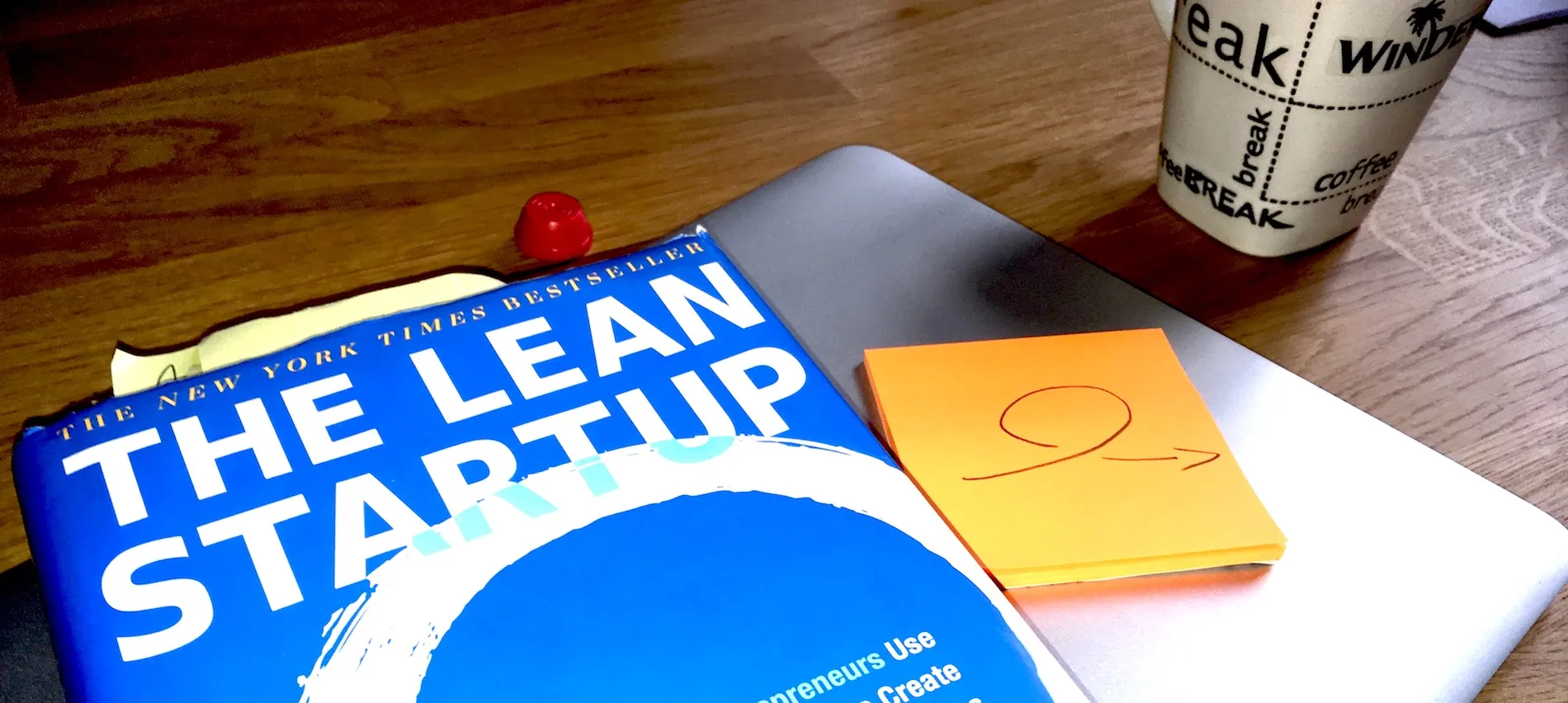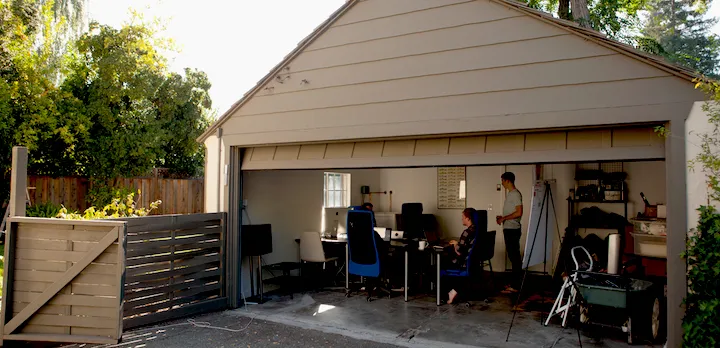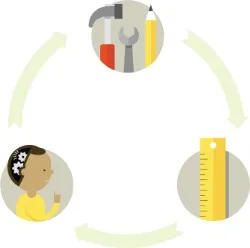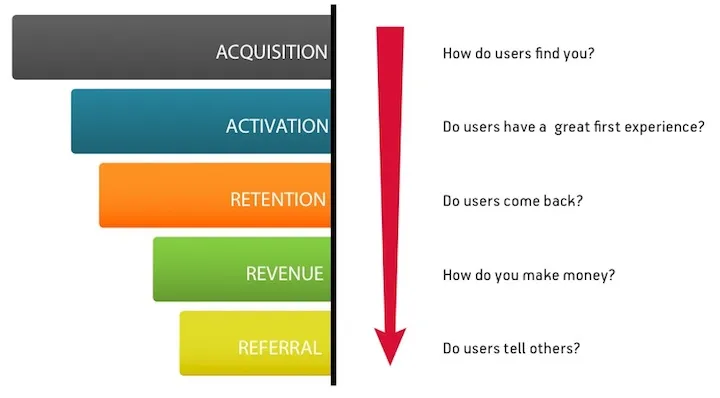
The Lean Startup : This Book Isn't Actually About Startups

“Don’t judge a book by its cover”… neither should you by its title.
I’ve read the book “The Lean Startup” by Eric Ries, it has now become a best seller and executives all around the world read it to understand how to overcome the challenges innovation brings.
Here’s a summary of my takeaways and how we use this knowledge for our customers.
What’s a Startup?
For most people, a startup is a new kind of company, working on awesome revolutionary ideas, with geniuses working in a garage.

For Eric Ries, a startup is “a human institution designed to create new products and services under conditions of extreme uncertainty”.
Whether this definition fits you or not, read “The Lean Startup” anyway, because it doesn’t actually talk about startups. It talks about innovation.
Then What Is Innovation?
Innovation is about finding a new solution to an existing problem ; that new solution can materialize in very varying ways :
- a technical disruption : Tesla and their electric cars
- a different business model : Airbnb and their market place
- a different customer segment : Stash and their micro investment platform
- …
For innovation to actually happen, and to be sustainable, we have to make sure that consumers recognize they have the problem, and that they are willing to buy a solution we’re able to build.
Quite far from the garage geniuses and the “Just do it and see” mentality.
What’s the Problem?
From Eric Ries’ point of view : the problem is, as entrepreneurs, that we trust so much our ideas that we assume what the consumers need. We then build an awesome plan, go for it, and wait until everything is ready to go live.
At that point, if our plan has been well executed and delivered on time, the project is considered successful. Or is it? What happens if the solution we imagined doesn’t actually fit what people need? What happens if we can’t sell it at all? We achieved failure.
We monitor how we execute the plan. But the plan isn’t always all that good, and we rarely find out until launch. In that case, most of our work suddenly becomes unworthy waste.

As most activities should rather be creating value than wasteful, we need to figure out the right thing to build rather than building on time and on budget something not needed.
How Do We Solve It?
In his book, Eric Ries proposes to use a method he calls The Lean Startup.
I particularly like one of the metaphors he uses to describe what it should be like :
When driving your car on your daily commute, you know where you’re going so well that you don’t even think about it. Yet if before leaving home, we asked you to plan exactly what you should do with your steering wheel and pedals to get to your destination, you wouldn’t be able to answer. You need the feedback your car gives you to know what to do. Contrary to the car, to launch a rocket you need to plan every little move. And if there’s a single error at the start it can have a disastrous effect way later.
Don’t try to launch a rocket, drive a car, and take advantage of all the feedback it provides.
The Lean Startup method suggests failing is part of building a successful innovation. If you can’t fail, there’s nothing you can learn. That said, learning shouldn’t be an excuse to failing, that’s where validated learning comes into play.
Validated Learning
In the lean startup movement, value is not creating stuff but rather learning until you find the right product-market fit.
That learning needs a frame and that’s where Eric Ries introduces validated learning. The root of this principle is to avoid learning from the mistakes we make when building things, but building in order to learn a particular thing from consumers.
For that use, he proposes to use what he calls the build measure learn feedback loop. You build your experiment, measure consumer behaviour, learn from it, act accordingly and repeat for your next experiment.

While the execution really goes in that order, to be able to plan it, you have to read it backward:
- What do we want to learn?
- What can we measure to help with our learning?
- What should we build to be able to measure consumer behaviour?
Most of business ideas are based on a leap of faith made about consumers. And that’s where the build measure learn loop shines : to test hypotheses.
What do we want to learn?
To know what needs to be built, we need to figure out what we want to learn first.
Most of the time, it starts with wanting to know if the unique value proposition makes sense for the defined target.
For one of our customers who wanted to automate a human-handled process to reach a new, bigger target, we asked ourselves if users were prone to talk to a machine instead.
We actually didn’t ask ourselves, nobody knew our new target enough, and even if that was the case, it would just have been an assumption. We needed to validate it!
What can we measure?
To be able to validate a leap of faith, we need to know how consumers behave.
At the end of the experiment, the hypothesis we want to learn about needs to have clear rules to know whether it’s actually true or not. This is achieved with the help of metrics : measure expected consumers behaviour and set a goal to it. e.g.: 25% of new visitors should sign up.
To make sure the metrics are meaningful, they should fit the 3A rule :
- Actionable : Be sure that the metric is actually impacted by the experiment and not external factors. (Careful with vanity metrics)
- Accessible : The metric should be easily understood by everyone.
- Auditable : In case there are doubts about the results of the experiment, our metric should be easily verifiable from its origin.
Most of the metrics we use are derived from AARRR metrics:

Back to our actual customer. We thought that the automation of our human-handled process could impact user retention. What is user retention in our particular case ? It’s how many - out of our new active users - would return when suggested a new action.
The process was already highly retentive, our customers assumed their initial hypothesis would be right if the user retention was over 60%…
What should we build?
Once at that step, all that is left to do is to build an experiment enabling to measure and learn what’s needed.
In the Lean Startup model, experiments are not just theoretical inquiries, they should be the product, it’s what makes the incremental approach possible.
Even being the product, the experiment is not meant to be perfect or complete. Its only use is to validate the hypothesis.
Eric Ries justifies the risk to pull consumers away with an imperfect product by opposing it to the risk of building something nobody wants. It makes sense.
He gives as example a few startups that have been very clever in testing their assumptions, with as few investment as possible :
- Dropbox and their “demo” video
- Zappos and their concierge MVP
- Groupon and their WordPress blog
YouTube might track you and we would rather have your consent before loading this video.
For our customer’s example, we suggested they lead a Wizard of Oz experiment, so that the automation could be faked by a human, at a very low cost, and with a very high fidelity.
Making good use of results
In the Lean Startup method, whether the result of the experiment validates or invalidates the hypothesis, it still accounts for validated learning. That new learning makes it possible to reach a better product market fit, or to reconsider the unique value proposition.
If the results are not significant enough, it most often means that the experiment should be refined, or detailed further.
The hardest part actually seems to be to know when we should persevere and try to learn more, or when we should pivot and change our value proposition.
But even if there are about 40 pages on this subject, Eric Ries sums it up in a single sentence :
The decreasing effectiveness of product experiments and the general feeling that product development should be more productive [should make you] consider a pivot”
Conclusion
Whether it is to find the product/market fit, tune the engine of growth, or pivot to a new value proposition, the proposed method is always the same : pick the most important hypothesis, build an experiment, measure consumers behaviour, capture learning, take action, repeat with next hypothesis.
When closing the book and trying to summarize what I learned, I realized that the universal recipe of innovation is just to put a team together and try to master validated learning in order to learn more efficiently, at a lower cost, and in a shorter time.
Since I read The Lean Startup, I found out Strategyzer offered a tool called “The Progress Board” meant to help manage validated learning. If you’re interested in the approach, you should probably give it a try!
If you’re interested in putting the Lean Startup in practice, we published a series of 18 blog posts on the subject two years ago. Head to A Lean Startup Adventure to learn more!
Authors

Facilitator at marmelab, Florian also gives lectures to IT students. He's a biker, plays the guitar, and brews his own beer.